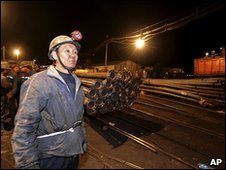
BEIJING — Rescue workers in northern China were racing on Monday to reach 153 miners who were trapped Sunday when water gushed into a warren of tunnels that were being dug for a new underground coal field.
Government officials say another 108 men scurried to safety as the mine began flooding Sunday afternoon. A preliminary investigation suggests that miners may have broken through to an adjacent subterranean pit where water had been accumulating, according to the official Xinhua news service.
Television news broadcasts on Monday showed workers feeding tubes into a shaft in an effort to drain the flooded mine, part of a network of tunnels being built at the Wangjialing Coal Mine, a 42-square-mile coal field in Shanxi Province that was scheduled to begin production later this year.
Xinhua said President Hu Jintao ordered that emergency workers “spare no effort” to save the miners. Official reports showed the country’s vice premiere, Zhang Dejiang, at the scene of the accident, which is about 500 miles southwest of Beijing.
The accident is a familiar tale in China’s coal-producing heartland, where safety standards often take a back seat to production. Coal fuels 70 percent of the nation’s energy needs, which have soared alongside the booming economy.
Although Chinese officials say the number of mining-related deaths has dropped by half in the past decade, 2,631 coal miners were killed by gas leaks, explosions or flooded tunnels last year, according to the State Administration of Work Safety.
If rescue efforts fail, it would be the deadliest accident since 2007, when 172 miners died in a flooded coal mine in Shandong Province. This year, there have been a spate of high-profile mine accidents, including an underground fire in Hunan Province that claimed 34 lives in January.
The worst incidents tend to occur in Shanxi, which produces 30 percent of the nation’s coal and has a reputation for illegal and poorly regulated mines. As part of a drive to cut down on embarrassing mining deaths, provincial authorities began a drive last year to reduce the number of mines and operators by forcing mergers between small, privately owned operations and state-owned companies. In the past year, according to government figures, the number of mines has been cut to 1,053 from 2,600, and more than 70 small companies have been forced into mergers.
But some experts have criticized the nationalization drive, saying it does not address underlying problems with China’s coal industry, including the lackluster enforcement of safety rules and a general disregard for the rights of workers.
Geoffrey Crothall, a spokesman for China Labour Bulletin, a workers’ advocacy group in Hong Kong, said it was telling that Huajin Coking Coal, the state-owned company that runs the Wangjialing mine, initially said there were 123 people trapped underground. “If you take safety seriously, you’re going to know how many miners are down in a shaft at any one time,” he said. “The bigger problem here is that for these companies, profits and coal production are their main concern.”